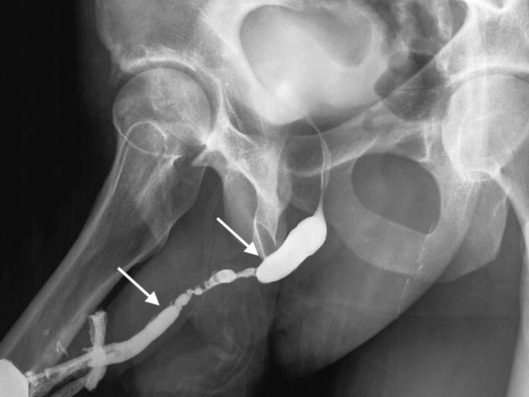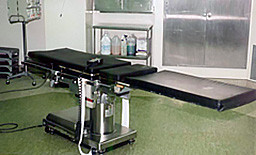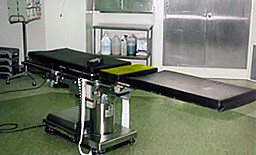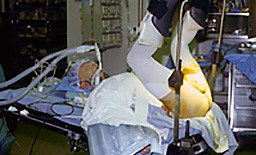If you have a urethral stricture, in general, you can do nothing (observation), have treatment to open up the stricture internally with urethral dilations or internal incisions (called urethrotomy), or have an open surgery for repair (called urethroplasty). Many of our patients come to us after having avoided urethoplasty for years while suffering from the stricture or having multiple failed dilation or internal urethrotomy procedures because they were under the impression that urethroplasty is a “major surgery” where their penis would be filleted open and that there were many serious risks of stricture surgery complications and severe pain after surgery. This is very misleading.
No one, other than perhaps a man with Psychiatric condition called Munchausen Syndrome, given the choice, wants to have surgery. However, the reason people have a particular surgery that can be associated with risks is generally because there are even more risks and problems that can happen when the surgery is not performed. This is especially true with urethral strictures.
When a man has a urethral stricture that is very narrow, for sure, every time the patient urinates, the bladder must squeeze longer and harder. Although many people go to the gym to lift weights to place stress on their muscles to make them grow and become stronger, organs like the bladder and heart become damaged when overworked.
There are many risks of urethral stricture complications when there is no treatment. Those risks include, in addition to straining to urinate and other symptoms, risks of urine infection and bladder and/or kidney damage that can be permanent and this type of damage is preventable. Many of our patients find themselves at times completely unable to urinate, something that can happen at any time, and then go to the emergency department while in excruciating pain as they wait for the doctor to try to force tubes through the urethra to tear open the stricture so the tube can reach and then drain the distended bladder. There are no effective medications or herbal or other natural urethral stricture cures, and without surgical treatment, the cure rate is zero.
Before moving on to discuss specific urethral stricture surgery complications or urethroplasty side effects, it should be mentioned that the risks of any surgery associated can include – death (we never had a patient die from having surgery), stroke, heart attack, pneumonia, or blood clot formation in the leg veins (called deep vein thrombosis) or in the lungs (called pulmonary embolism. These are uncommon. What helps prevent these complications is when patients are without major medical problems. When patients have problems such as heart conditions, they generally are first evaluated by their primary care doctors to insure the risk of cardiac complications is low. This is generally true for all surgeries.
Since the treatment options fall into 2 main categories – minor procedure treatments to dilate-tear the urethra open through instruments placed through the penis, and open urethral surgery to repair the area of stricture, called urethoplasty, each will be reviewed separately.
Complications of Dilation and internal incision (also called DVIU or direct vision internal urethrotomy).
By far, the most common complication of urethral dilation or urethrotomy is recurrence of the stricture. These short outpatient procedures are associated to with the subsequent insertion of a catheter in the urethra that usually remain in place for several days after the procedure and then removed. If you define “success” as a wide open urethra for at least a day or a week or a month after the catheter is removed, then the success rate is very high. Patients are often amazed at how well they can urinate compared to before the procedure. The problem is that this is generally short lived. The cure rate, when you define cure as when the urethra stays wide open permanently is very low, as low as 0-8%, especially for longer strictures or with repeated treatments.
Making things worse is that when the stricture recurs, it is often longer and more dense than before. This is not because the patient just happens to form and build up scar tissue. This happens because when the urethra is dilated = torn open, or cut open in specific places (urethrostomy), it is injured on purpose, and injuries always heal with a scar, and over time that scar contracts as nothing was really repaired. The more the urethra is “injured” the longer the scar can become.
We have never been able to do a research study to determine just how often these dilations and incisions lead to strictures becoming worse and to what extent. This is because over 90% of our patients from the United States who have had failed endoscopic urethral stricture treatments (dilation and/or urethrotomy) never had proper diagnostic urethral X-ray imaging to assess the stricture length (which should have been done) before treatment. The following is an example of the imaging of a man who had a DVIU – direct vision internal urethrotomy, and then presented to us with a 5 cm long extremely narrow stricture.

complication of direct vision internal urethrotomy
There was no imaging before this procedure, and therefore it can’t be determined if this was a short stricture that was made considerably longer as a urethrotomy complication or if the stricture was a 5-cm long stricture before treatment, and the patient was not aware of alternatives or the fact that the cure rate of urethrotomy for a stricture with that length and appearance is approximately zero.
The best data comes from Dr. A. Horiguchi in Japan. In Japan, Urologists are more likely to do urethral imaging before providing treatment providing a basis for comparison of the stricture length before the surgery and after surgery when there is a recurrence.
This published study nicely describes how these transurethral treatments (dilations and internal incisions from within the urethra) generally make the problem worse in the long run, and complicate the urethroplasty surgery needed for definitive repair.
Other complications of dilation and internal urethrotomy include major bleeding, false passage, and infection, and even rectal injury.
When instruments are advanced into the urethra blindly to stretch or tear the stricture open, the tip of the instruments (often metal rods of increasing size) may go into the wrong space, and as this wrong space gets dilated, a false passage is created. In some cases, if the urethra is torn clear through, there can be bleeding into the tissues surrounding the urethra causing scrotal swelling. In rare cases, the rectum can be punctured.
In an effort to reduce these false passage and perforation risks, Dr. Gelman developed a balloon dilator in 1999 that can be more safely used to dilate-tear the urethra open under direct vision. It was published on the cover of the Journal of Endourology in 2011.
Although this dilator makes urethral dilation safer, we never suggested it offered a higher long-term success rate compared to other dilation or incision methods.
The most common urethral stricture complication following open surgical repair, called urethroplasty, is stricture recurrence (although the recurrence rate of urethroplasty is far lower than the recurrence rate following dilation or DVIU. Stricture recurrence is when urethral strictures return following what was thought to be a successful treatment. Very discreet, band-like strictures can be treated with a simple incision, but if there is more extensive narrowing, treatment can be very troublesome.
Re-do repairs to treat urethral stricture surgery complications are often very complex, and reconstructive surgical options are often more limited. The success of open urethroplasty is extremely dependent on the surgical technique and the expertise of the surgeon, making it essential to only undergo surgery at a urology center that is dedicated to the treatment of urethral stricture disease. Early recurrence of the stricture is one of the most common stricture surgery complications if the surgery is not properly performed.
The Importance of Finding a Stricture Surgery Specialist
At the Center for Reconstructive Urology, we exclusively specialize in urethral stricture and related male genital surgery, and our expertise and experience results in relatively few complications following surgery and usually very little post-operative pain. This level of success has led to many of our patients arriving as a referral from several hundred different Urologists over the past 20+ years. Most of these local urologists are certified to perform urethral reconstruction along with all other Urological procedures such as prostate cancer surgery, Female Urology, kidney stone surgery and other procedures involving the urinary tract. However, they refer their patients to our Center because they believe surgical success is best achieved at The Center for Reconstructive Urology with Dr. Gelman, a fellowship-trained sub-specialist whose practice is exclusively devoted to male urethral-genital reconstructive surgery.
Insurance Can Redirect Patients to Unqualified Urologists
In some cases, patients have been referred to us only to find The Center for Reconstructive Urology is out of their insurance network. Contrary to the wishes of the referring Urologist, the insurance company redirects the patient to a different in-network Urologist that is willing to attempt the repair. While it is reasonable for patients to be redirected if the motivation is to find a doctor more qualified, these decisions are usually made by insurance companies with little understanding of urology. The main goal of the redirection is to seek a physician and institution who will accept the patient at the lowest available rate.
In every case where patients have been redirected, it has not been to a Urologist more qualified based on training. In fact, patients are usually redirected to doctors who do not specialize in male urethral and genital reconstructive surgery and only perform the surgery part-time. Unfortunately, redirected patients usually tend to have failed outcomes and urethral stricture complications that can lead to disastrous results. Only after stricture surgery complications occur are the patients redirected to us, this time with insurance authorization, for complex re-do surgery. What most reinforces the fact that expertise makes a major difference in the outcome, is when our patients are referred to our Center with problems where our published success rate is 100% short term and 99.3% long term, have failed surgery, then have approval to have re-do surgery at our Center that is successful, but with a more complicated surgery. These unfortunate men have to undergo 2 major surgeries instead of one. https://www.centerforreconstructiveurology.org/video-library/insurance-complication/
Positioning-Related Stricture Surgery Complications
Certain urethral stricture repair surgeries require that the patient be placed in the lithotomy position, a position in which both legs are raised in the air in stirrups. More specifically, bulbar and membranous stricture repair (strictures underneath the penis) requires the patient to be in the lithotomy position, as the surgery is generally performed through an incision in the perineum, the area under the scrotum. If a patient is in the lithotomy position for an extended period of time, it is not uncommon for the top of their feet to experience numbness or tingling. This is not a significant problem if normal sensation returns sometime between 1 and 2 days, but a very prolonged sensation change is a cause for concern. Several of our patients have experienced this complication that eventually resolved, most of whom came into our center with complex strictures following a prior surgery that required extensive re-do reconstruction.
More serious positioning-related urethral stricture surgery complications include damage that affects foot or other leg movements. One such complication is called compartment syndrome. Compartment syndrome is when there is prolonged compression of the calves, leading to a build-up of pressure within the lower leg. This is considered a surgical emergency and must be treated immediately. Treatment consists of making deep, long incisions in the legs (called fasciotomies) to relieve the pressure.
To date, the Center for Reconstructive Urology has not had a single patient experience this positioning-related urethral stricture complication. However, we have seen patients who have reported a history of prior stricture surgery complications from poor positioning, including compartment syndrome or nerve damage that required them to use a walker or a wheelchair at the time of discharge.
We believe that the use of special equipment, along with careful attention to detail during positioning, can significantly reduce the risk of these complications. It is this cutting-edge equipment and extreme attention to detail that has led to our success with lithotomy positioning. At UC, Irvine Medical Center, all urethral reconstructive surgeries are performed using a Custom Skytron 6000 OR Table with a Jordan modification (as shown in yellow) to allow pelvic tilt.



This table is designed specifically for urethral reconstructive surgery. As the pelvic portion tilts, the legs are proportionally raised. This prevents leg or hip flexion while simultaneously providing the pelvis with adequate support. Our stirrups are also custom modified according to Dr. Gelman’s preferences, allowing for the additional extension needed to further prevent excessive hip or knee flexion. The table’s unique design combined with the use of Dr. Gelman’s custom made stirrups means that no pressure is placed on the patient’s calves, and great care is taken to prevent pressure points.
We also try to minimize the time a patient is in the lithotomy position. For example, if a graft from inside the cheek (buccal mucosa) is required, this graft is harvested with the patient lying flat before placing them in the lithotomy position.
Erectile and Ejaculatory Dysfunction
It has been reported that after urethral stricture surgery, there can in some cases be sexual dysfunction such as decreased erection rigidity. Fortunately, when this urethral stricture surgery side effect occurs, there is resolution within 6 months. We closely monitor and document urinary and sexual function after surgery always seeking to make technical modifications to minimize risks, with one technical modification presented at the Annual Meeting of the American Urological Association in 2019. We have found that the specific techniques we use are associated with the least possible risk.
There are many other potential complications of urethral stricture reconstructive surgery, such as bleeding, infection, wound breakdown, tightness with erections (generally temporary), and dribbling. All surgery is associated with some risk, but if urethral surgery is properly performed, these risks are very low and blood loss is generally minimal. As is true with all surgery and urethroplasty in particular, the risk of a particular complication is highly related to surgeon expertise, and to some extent, equipment and instrumentation. There have been papers published indicating that in some series, multiple patients have had blood loss requiring transfusion or needed to be taken back to the operating room shortly after surgery for unclear reasons, and yet with an experience of approximately 2,000 cases, we have never had these particular complications.
Although reading about the above risks may cause a man to be afraid of having urethroplasty, In general, the risks associated with not treating a stricture far outweigh the risks of a properly performed open repair.

